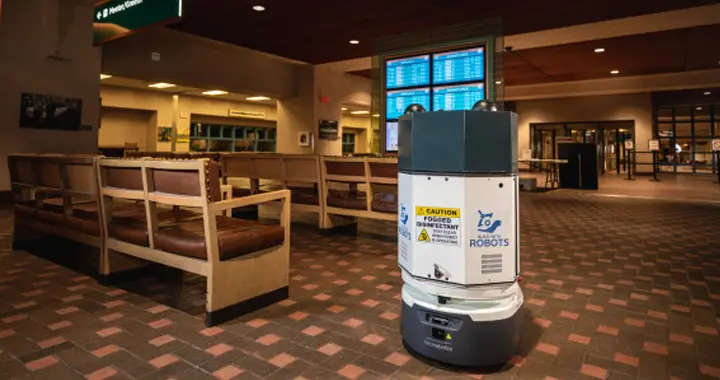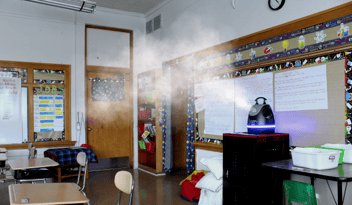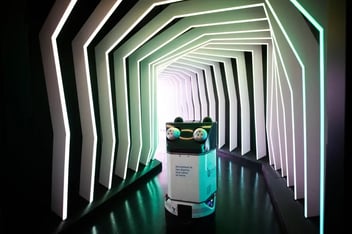
These Fog-spraying Robots Kill the Coronavirus
Every night, after the last plane has landed at the Albuquerque airport, and all the passengers have left the terminal, a robot rolls out of a closet and begins filling the room with fog. Following a predetermined map of the space and rolling at the pace of a quick walk, the robot zips through the empty terminal, puffing a disinfectant powerful enough to kill anthrax. After covering about 100,000 square feet over the course of an hour and a half, the robot returns to its closet.
This robot is a powerful and somewhat sci-fi new tool in the fight against the COVID-19 pandemic and the virus that caused it. And it’s coming to clean the high-touch surfaces of airport terminals, offices, and warehouses, eliminating 99.9999% of bacteria and viruses.
Named Breezy One, the roving disinfection robot was created through a partnership between Fetch Robotics, a warehousing and logistics robotics company based in San Jose, California, and Build With Robotics, an Albuquerque-based industrial robotics company. Using Fetch’s autonomous and programmable robot as a base with a fog-sprayer add-on developed by Build With Robotics, Breezy One uses an EPA-registered disinfectant originally developed by Sandia National Laboratories for the decontamination of chemical and biological agents. The robots are available for between $6,000 and $9,000 a month.

Breezy One is far from the only disinfecting robot on the market, though most of the others now available rely on using ultraviolet light to disinfect, eliminating 99.9 percent of bacteria and viruses. The fog-based approach is meant for more intensive disinfection of places with shared surfaces and high-contact equipment.
After a human guides it through a space with a joystick control, the robot creates an internal map of its setting and automatically charts the most efficient path to fog the entire space. Human operators need only to disengage the robot from its charging base, start the fogging cycle, and get out of the way. Rooms are safe to reenter about two hours after disinfection.
A disinfecting robot was a pivot for Fetch Robotics, according to CEO Melonee Wise. One of Fast Company’s Most Innovative Companies in 2018 and 2019, Fetch focuses primarily on robots that autonomously move pallets around warehouses. But when the pandemic kicked in, her customers found themselves short-staffed and unable to operate safely. “We had customers who were just like ‘I’ll do anything. Can you tell us about any solution you have to clean or disinfect our environment so we can get people back to work?'” Wise says. She realized the company’s technology could be easily adapted to help.

Fetch teamed up with Build With Robotics and came up with the fog-spewing Breezy One. Development took just a few months, and the robot was disinfecting spaces like the Albuquerque airport terminal by this summer. “Our robot was already a platform. It’s relatively easy for our customers to attach accessories to it to build new robots for different markets,” Wise says.
Breezy One was just the start. Fetch partnered with another robotics company to create a less intensive disinfecting robot that uses ultraviolet light to clean the surfaces in rooms and offices, eliminating 99.9 percent of bacteria and viruses. “The robots go right into a conference room after a meeting and disinfect the entire room in about 15 minutes,” Wise says.
She says orders for the two robots have been in the hundreds, and there’s been interest from a variety of businesses and venues. “It’s everything from casinos to public schools to airports to shared work spaces or co-work spaces to warehouses and manufacturing facilities,” she says. “We’re seeing the whole spectrum.”
Though these kinds of heavily trafficked places can benefit from disinfection, most of the transmission of COVID-19 happens from person to person contact through the air. Cleaner surfaces in public places and work spaces can help, but it’s only part of the solution. The more effective preventative measures—keeping safe distance and wearing masks—require no added robots.




